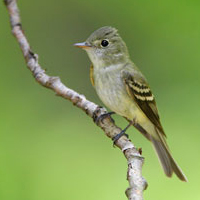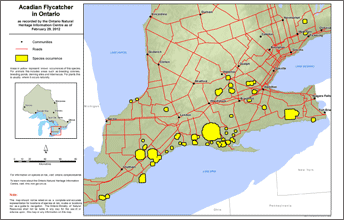Acadian Flycatcher
Scientific name: Empidonax virescens

Cover photo credit: Brian E. Small
Status
Endangered
“Endangered” means the species lives in the wild in Ontario but is facing imminent extinction or extirpation.
Date added to the Species at Risk in Ontario List
The Acadian Flycatcher was assessed as endangered when the Endangered Species Act took effect in 2008.
What it looks like
The Acadian Flycatcher has an olive-green crown, back and tail with a pale whitish throat and breast.
The most prominent feature of this bird is the bold white ring around the eye, and two whitish horizontal bars on the wing.
The beak is short but wide-based, allowing a big opening for snatching insects out of the air.
The best way to identify the Acadian from similar looking flycatchers is its explosive song, often interpreted as “peet-sah”, with a strong emphasis on the first syllable.
Where it lives
It is typically found in mature, shady forests with ravines, or in forested swamps with lots of maple and beech trees. The nest is placed near the tip of a lower limb on a tree, and is loosely woven, with strands of plant material hanging down.
In Canada, the Acadian Flycatcher nests only in southwestern Ontario, mostly in large forests and forested ravines near the shore of Lake Erie.
Where it’s been found in Ontario
In Ontario, the Acadian Flycatcher primarily lives in the warmer climate of southern Ontario’s Carolinian forests. It needs large, undisturbed forests, often more than 40 hectares in size.
It has also been known to nest at a few sites in the Greater Toronto Area but this is unusual. The Acadian Flycatcher population in Ontario is very small, with 25 to 75 breeding pairs recorded in 2010.
View a Larger version of this map (PDF)
What threatens it
The main threat to the Acadian Flycatcher is habitat loss and degradation due to clearing of forests for agricultural and urban development.
The larger tracts of mature forest that are closed-canopy with open understorey, preferred by the species, are relatively rare to uncommon in southern Ontario.
Action we are taking
Endangered Species and their general habitat are automatically protected
Recovery strategy
A recovery strategy advises the ministry on ways to ensure healthy numbers of the species return to Ontario.
Read the recovery strategy (December 14, 2016)
Government response statement
A government response statement outlines the actions the government intends to take or support to help recover the species.
Read the government response statement (September 12, 2017)
Review of progress
A review of progress made toward protecting and recovering a species is required no later than the time specified in the species’ government response statement, or not later than five years after the government response statement is published if no time is specified.
Read the report on progress towards the protection and recovery of 12 species at risk, including Acadian Flycatcher (2022).
Habitat protection
General habitat protection - June 30, 2013
What you can do
Report a sighting
Report a sighting of an endangered animal or plant to the Natural Heritage Information Centre. Photographs with specific locations or mapping coordinates are always helpful.
Learn more about reporting wildlife.
Volunteer
- Volunteer with your local nature club or provincial park to participate in surveys or stewardship work focused on species at risk.
Be a good steward
- Private land owners have a very important role to play in species recovery. If you find an Acadian Flycatcher nesting on your land, you may be eligible for stewardship programs that support the protection and recovery of species at risk and their habitats.
Report illegal activity
- Report any illegal activity related to plants and wildlife to
1-8766-MOE-TIPS (663-8477) .
For more on how you can help, visit Bird Studies Canada.
Quick facts
- The Acadian Flycatcher only spends about four months of the year in Canada. The rest of the time, it is migrating or wintering in the tropical forests of Central America and northern South America.
- The Carolinian forests where this bird lives in Ontario were named by early explorers, who observed that the deciduous forests in southwestern Ontario were similar to more southerly temperate forests found in the Carolinas and elsewhere in the eastern United States.
- Ontario’s Carolinian forest supports more than 40 per cent of Canada’s species at risk and is one of the most threatened habitats in Canada.
